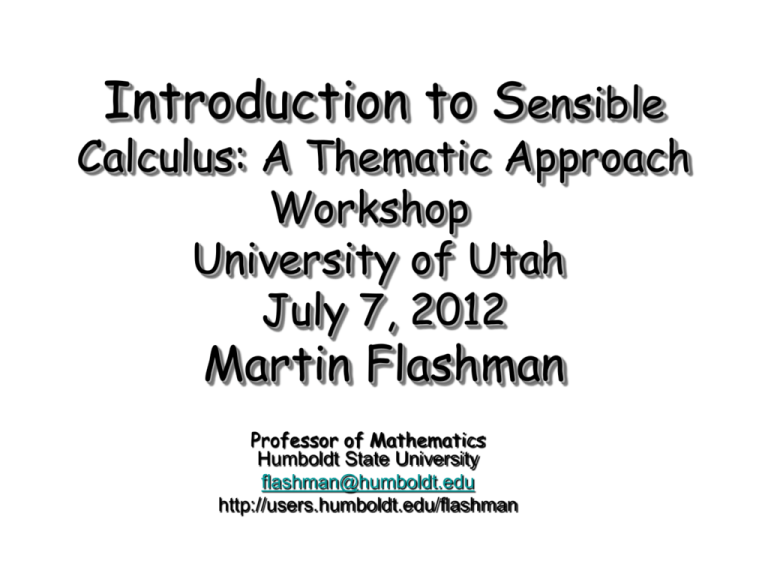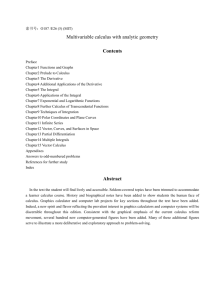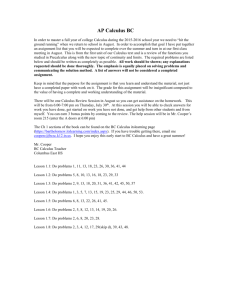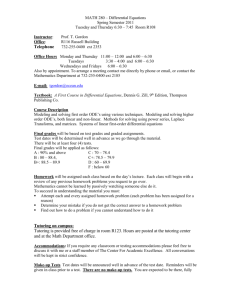
Introduction to Sensible
Calculus: A Thematic Approach
Workshop
University of Utah
July 7, 2012
Martin Flashman
Professor of Mathematics
Humboldt State University
flashman@humboldt.edu
http://users.humboldt.edu/flashman
The Sensible Calculus Program
• Primary Creator: Martin Flashman
– Since 1981.
– Associate: Tami Matsumoto (since 2006)
• Main Web Page (2002)
• Many materials currently available on-line
through the main web page.
• Key content and pedagogical concepts will
be the focus of this workshop.
Session I Calculus Mapping
Figures
We begin our introduction to mapping
figures by a consideration of linear
functions :
“ y = f (x) = mx +b ”
Mapping Figures
A.k.a.
Function diagrams
Transformation Figures
Dynagraphs
Written by Howard Swann and John Johnson
A early source for visualizing functions at an
elementary level before calculus.
This is copyrighted material!
Function Diagrams by Henri Picciotto
a
b
a
b
Mapping Diagrams and Functions
• SparkNotes › Math Study Guides › Algebra II:
Functions Traditional treatment.
– http://www.sparknotes.com/math/algebra2/functions/
• Function Diagrams. by Henri Picciotto
Excellent Resources!
– Henri Picciotto's Math Education Page
– Some rights reserved
• Flashman, Yanosko, Kim
https://www.math.duke.edu//education/prep02/te
ams/prep-12/
Ideas
•
•
•
•
•
•
•
Interpretation of axes
Linear
Nonlinear (quadratic, trig, exp/ln, 1/x)
inverses
Composition
Derivative (visualize rate/ratio)
Differential
Linear Functions: Tables
x
3
2
1
5 x - 7
Complete the table.
x = 3,2,1,0,-1,-2,-3
f(x) = 5x – 7
0
-1
f(0) = ___?
-2
-3
For which x is f(x) > 0?
Linear Functions: Tables
xX
5 x – 7
f(x)=5x-7
3 3
88
2 2
33
1
-2
1
-2
0
-7
0
-7
-1
-12
-12
-2 -1
-17
-17
-3 -2
-22
-3
-22
Complete the table.
x = 3,2,1,0,-1,-2,-3
f(x) = 5x – 7
f(0) = ___?
For which x is f(x) > 0?
Linear Functions: On Graph
Plot Points (x , 5x - 7):
X
5 x – 7
3
8
2
3
1
-2
0
-7
-1
-12
-2
-17
-3
-22
Linear Functions: On Graph
Connect Points
(x , 5x - 7):
X
5 x – 7
3
8
2
3
1
-2
0
-7
-1
-12
-2
-17
-3
-22
Linear Functions: On Graph
Connect the Points
X
5 x – 7
3
8
2
3
1
-2
0
-7
-1
-12
-2
-17
-3
-22
Linear Functions:
Mapping Figures
• Connect point x to
point 5x – 7 on axes
X
5 x – 7
3
8
2
3
1
-2
0
-7
-1
-12
-2
-17
-3
-22
Linear Functions:
Mapping Figures
X
5 x – 7
3
8
2
3
1
-2
0
-7
-1
-12
-2
-17
-3
-22
8
7
6
5
4
3
2
1
0
-1
-2
-3
-4
-5
-6
-7
-8
-9
-10
-11
-12
-13
-14
-15
-16
-17
-18
-19
-20
-21
-22
Sensible Calculus Resources
• Visualizations and Transformation
Figures
• Ch 0.B.2 Functions-Introduction and
Review.
Examples on Excel, Winplot,
Geogebra
• Excel example:
• Winplot examples:
– Linear Mapping examples
• Geogebra examples:
– dynagraphs.ggb
• Web links:
– https://www.math.duke.edu//education/prep02/teams/prep-12/
– http://www.dynamicgeometry.com/JavaSketchpad/Gallery/Trigon
ometry_and_Analytic_Geometry/Dynagraphs.html
– http://demonstrations.wolfram.com/Dynagraphs/
– http://demonstrations.wolfram.com/ComposingFunctionsUsingDy
nagraphs/
– http://users.humboldt.edu/flashman/TFLINX.HTM
Simple Examples are important!
f(x) = mx + b with a mapping figure -Five examples:
• Example 1: m =-2; b = 1: f(x) = -2x + 1
• Example 2: m = 2; b = 1: f(x) = 2x + 1
• Example 3: m = ½; b = 1: f(x) = ½ x + 1
• Example 4: m = 0; b = 1: f(x) = 0 x + 1
• Example 5: m = 1; b = 1: f(x) = x + 1
Visualizing f (x) = mx + b with a mapping
figure -- Five examples:
Example 1: m = -2; b = 1
f (x) = -2x + 1
Each arrow passes through a single
point, which is labeled F = [- 2,1].
The point F completely determines the
function f.
given a point / number, x, on the source
line,
there is a unique arrow passing through
F
meeting the target line at a unique point
/ number, -2x + 1,
which corresponds to the linear function’s
value for the point/number, x.
Visualizing f (x) = mx + b with a
mapping figure -- Five examples:
Example 2: m = 2; b = 1
f(x) = 2x + 1
Each arrow passes through a single
point, which is labeled
F = [2,1].
The point F completely determines
the function f.
given a point / number, x, on the source
line,
there is a unique arrow passing through
F
meeting the target line at a unique point
/ number, 2x + 1,
which corresponds to the linear function’s
value for the point/number, x.
Visualizing f (x) = mx + b with a
mapping figure -- Five examples:
Example 3: m = 1/2; b = 1
f(x) = ½ x + 1
Each arrow passes through a single
point, which is labeled F = [1/2,1].
The point F completely determines the
function f.
given a point / number, x, on the source
line,
there is a unique arrow passing through F
meeting the target line at a unique point /
number, ½ x + 1,
which corresponds to the linear function’s
value for the point/number, x.
Visualizing f (x) = mx + b with a mapping
figure -- Five examples:
Example 4: m = 0; b = 1
f(x) = 0 x + 1
Each arrow passes through a single
point, which is labeled F = [0,1].
The
point F completely determines the
function f.
given a point / number, x, on the source
line,
there is a unique arrow passing through F
meeting the target line at a unique point /
number, f(x)=1,
which corresponds to the linear function’s
value for the point/number, x.
Visualizing f (x) = mx + b with a
mapping figure -- Five examples:
Example 5: m = 1; b = 1
f (x) = x + 1
Unlike the previous examples, in this case it is not a single point that
determines the mapping figure, but the single arrow from 0 to 1,
which we designate as F[1,1]
It can also be shown that this single arrow completely determines the
function.Thus, given a point / number, x, on the source line, there is a
unique arrow passing through x parallel to F[1,1] meeting the target
line a unique point / number, x + 1, which corresponds to the linear
function’s value for the point/number, x.
The single arrow completely determines the function f.
given a point / number, x, on the source line,
there is a unique arrow through x parallel to F[1,1]
meeting the target line at a unique point / number, x + 1,
which corresponds to the linear function’s value for the point/number, x.
Mapping Figures and The
Derivative
Motivation and Balance
Estimation and Local
Linearity
The Sensible Calculus Program
Introduction to the Derivative
• Motivation for the derivative as a number,
visual and numerical estimation with
graphs and mapping figures.
• Ch 0 A Motivation: What is the calculus?
• Ch 0 B Solving the Tangent Problem
• Ch 1 A Tangent Line
• Ch 1 B Velocity
• Ch 1 D Derivative ( Four Steps)
End of Session I
• Questions
• Break - food and thought
• Partner/group integration task
Morning Break: Think about These
Problems
M.1 Use a mapping figure for the function f (x) = -3x + 2 to illustrate that
f (1) = -3.
Sketch a mapping figure that illustrates the work to show that the linear
function f (x) = mx + b has f (a) = m. Discuss how different values of m
impact your figure.
M.2 Use a mapping figure for the function f (x) = x2 to illustrate that
f (3) = 6.
Sketch a mapping figure that illustrates the work to show that f (a) = 2a.
M.3 Use a mapping figure for the function f (x) = 1/ x to illustrate that
f (2) = -1/4.
Sketch a mapping figure that illustrates the work to show that f (a) = -1/a2.
Session II Differential Equations,
Approximation and The
Fundamental Theorem of Calculus
We continue our introduction to A
Sensible Calculus by a consideration of
the FT of Calculus from a sensible
view of DE’s and estimations using
Euler’s Method interpreted in as
variety of contexts.
The Sensible Calculus Program
The FT of Calculus, DE’s, and Euler’s Method
• Motivation for the FT of C from estimating a solution to
an Initial Value Problem, visual and numerical estimation
with graphs and mapping figures. Sensible and balanced
interpretation the FT of C and integrals.
• Ch III.A.1. THE DIFFERENTIAL
• Comment on the Mean Value Theorem, Implicit
Differentiation, Related Rate, and “graphing”
Applications being connected to DE’s
• Ch IV Differential Equations from an Elementary
Viewpoint
• V.A The Definite Integral
Conversion
• Discuss how to convert the following
exercises to visualize the motivating
problem with mapping figures.
Discussion: What are the advantages?
Disadvantages?
• Introduction to Integration - The Exercise
Bicycle Problem: Part 1 Part 2
by Marc Renault, Shippensburg University.
End of Session II
• Questions
• Lunch Break - food and thought
• Partner/group integration task
Lunch Break: Think about These Problems
L.1 Assume y is a solution to the differential equation
dy/dx= 1/(x2 + 1) with y(0)=2.
(a) Using just the given information, find any local extreme points for y
and discuss the graph of y, including the issue of concavity.
(b) Using the differential, estimate y(1) and y(-1).
L.2 Assume y is a solution to the differential equation
dy/dx= 1/(x2 + 1)
(a) Sketch the tangent field showing tangents in all four quadrants.
(b) Draw three integral curves on your sketch including one through the point
(1,2);
(c) Suppose that a solution to the differential equation has value 2 at 1.
(i) Based on your graph, estimate the value of that solution at 2.
(ii) Estimate the value of y(3) using Euler's method with n = 4.
L.3 Assume y is a solution to the differential equation
dy/dx = -y/x
(a) Sketch the tangent field showing tangents in all four quadrants.
(b) Draw three integral curves on your sketch including one through the point
(1,2);
(c) Suppose that a solution to the differential equation has value 2 at 1.
(i) Based on your graph, estimate the value of that solution at 2.
(ii) Estimate the value of y(2) using Euler's method with n = 4.
L.4Suppose y'' = -y , y'(0) = 1 and y(0) = 0. Estimate y(1), y(2), y(3), and y(4).
Session III More on DE’s and
Estimations
Pedagogy: Fundamental Concepts,
not “foundations”.
We continue our introduction to Sensible
Calculus by considering the pedagogy
for conceptual approaches. Models and
connecting with the familiar.
The Sensible Calculus Program
More on DE’s, Models and Estimations
• Modeling contexts provide a sensible source for for DE’s and both
practical and theoretical use of concepts and skills. Pedagogical
decisions are made to stay focused on the themes by engaging
students in balanced approaches using visual, symbolic, numerical
and verbal approaches.
• VI.A Differential Equations & Models- The
Exponential Function
• VI.B Differential Equations & Models- The
Natural Logarithm Function
• VI.C Connecting the Natural Logarithm and
Exponential Functions
• VI.D More Models & Inverse Trigonometry
• IXA Taylor Theory for ex
“Pedagogical” Principles
• Themes of differential equations and estimation
throughout the first year of calculus, using modeling as a
central motivation for applications of the calculus.
• “…everything in a calculus course can be related to the
study of differential equations. “
• “…estimation is valuable for both numerical and
conceptual development. “
• The consistent use of interpretations to provide meaning
for calculus concepts.
• “… models as sources for concepts and interpretations
as well as for applications.”
• Present examples of models or arguments before more
general applications and proofs.
• Informal understanding habits form a learning
foundation for later concept, language, and
notation definitions.
• Students can understand the specific and
particular in experience and then generalize
more easily then they can understand a general
proposition or proof and the apply it to the
particular.
• If a topic is sensibly organized by itself and
sensibly placed with regard to the other topics,
then it should remain a part of the course. But if
it fails to make sense locally or globally, it needs
careful reassessment and revision.
End of Session III
• Questions
• Break - food and thought
• Partner/group integration task
Session IV Amazing Results:
Integral of exp(-x2)
Newton’s Estimate of ln(2)
We complete our introduction to the
Sensible calculus by a consideration of
some amazing results that provide
both motivation and consolidation for
the first year experience with
calculus.
Amazing Results
• How Newton used Geometric series to find ln(2)
• Finding
e
x2
dx
Session V Mapping Figures and
Technology
Technological support for the Sensible
Calculus… What do you need?
Winplot
Excel
Graphing calculators
Geogebra and GSP
Mathematica, etc.
Examples on Excel, Winplot,
Geogebra
•
Excel example(s):
•
Winplot examples:
•
Geogebra examples:
– Mapping figures and graphs
– Euler’s Method
– Integral Estimates
–
–
–
–
Linear Mapping examples
Direction Fields; Euler’s Method
Integral Estimates
Taylor Theory
– geogebratube
– dynagraphs.ggb
– Composition.ggb
• Other Web links:
–
–
https://www.math.duke.edu//education/prep02/teams/prep-12/
http://demonstrations.wolfram.com/topics.html?Mathematics#2
– http://www.wolframalpha.com
Thanks
The End!
Questions?
flashman@humboldt.edu
http://www.humboldt.edu/~mef2
Mapping Diagrams and Functions
• SparkNotes › Math Study Guides › Algebra II:
Functions Traditional treatment.
– http://www.sparknotes.com/math/algebra2/functions/
• Function Diagrams. by Henri Picciotto
Excellent Resources!
– Henri Picciotto's Math Education Page
– Some rights reserved
• Flashman, Yanosko, Kim
https://www.math.duke.edu//education/prep02/te
ams/prep-12/
• [FL1] Flashman, Martin. "Differential Equations: A Motivating Theme
for A Sensible Calculus," in "Calculus for All Users" The Report of A
Conference on Calculus and Its Applications Held at the University
of Texas, San Antonio, NSF Calculus Reform Conference, October
5 - 8, 1990.
• [UMAP] Flashman, Martin. "A Sensible Calculus.," The UMAP
Journal, Vol. 11, No. 2, Summer, 1990, pp. 93-96.
• [FL2] Flashman, Martin. "Using Computers to Make Integration More
Visual with Tangent Fields," appearing in Proceedings of the
Second Annual Conference on Technology in Collegiate
Mathematics, Teaching and Learning with Technology of November
2-4, 1989, edited by Demana, Waits, and Harvey, Addison-Wesley,
1991.
• [FL3] Flashman, Martin. "Concepts to Drive Technology," in
Proceedings of the Fifth Annual Conference on Technology in
Collegiate Mathematics, November 12-15, 1992, edited by Lewis
Lum, Addison-Wesley, 1994.
• [FL4] Flashman, Martin. "Historical Motivation for a Calculus Course:
Barrow's Theorem," in Vita Mathematica: Historical Research and
Integration with Teaching, edited by Ronald Calinger, MAA Notes,
No. 40, 1996.






